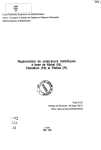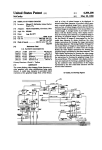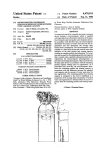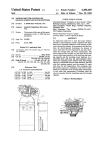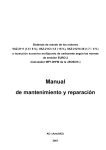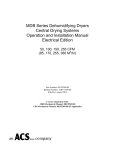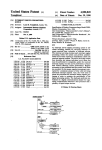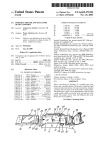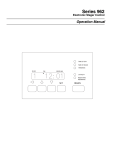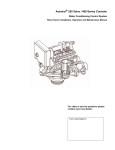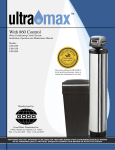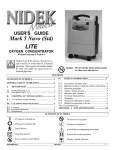Download Determination of necessity for regeneration
Transcript
United States Patent [19] [11] Patent Number: 4,469,602 Seal [45] Date ‘of Patent: Sep. 4, 1984 [54] MICROCOMPUTER CONTROLLED DEMAND/SCHEDULED WATER SOFTENER HAVING AUTOMATIC RESIN BED SENSING OTHER PUBLICATIONS Operating Manual, “Compute-A-Save System”, Water Re?ning Company, Middletown, Ohio, Jul. 1, 1978. [75] Inventor: J. David Seal, Waukesha, Wis. Sales Literature, “Water King”, Sta-Rite Industries, Dela?eld, Wisc. Sales Literature, “The Lindsay KNOW-IT-ALL”, [73] Assignee: Autotrol Corporation, Milwaukee, The Lindsay Corporation. Wis. Primary Examiner—1vars C. Cintins Attorney, Agent, or Firm—-Quarles & Brady [57] ABSTRACT [21] Appl. No.: 502,967 [22] Filed: [63] An improved control for a water softener includes a Jun. 10, 1983 Related US. Application Data Continuation-impart of Ser. No. 412,279, Aug. 27, 1982, Pat. N0. 4,426,294. [51] Int. Cl.3 [52] US. Cl. .................................... .. 210/662; 210/85; ..... . . . . . . . . . .. B01J 49/00 210/89; 210/98; 210/140; 210/143; 364/502 [58] Field of Search ............... .. 210/662, 670, 687, 89, 210/98, 102, 103, 109, 140, 143, 190, 191, 26.9, 85; 364/500, 502 [56] References Cited U.S. PATENT DOCUMENTS 4,237,538 12/1980 Le Dall ............................. .. 364/500 4,257,887 4,275,448 4,332,678 4,385,357 3/1981 6/ 1981 6/1982 5/1983 resin bed sensor for sensing when the resin bed has been depleted to a predetermined percentage of the total resin bed treating capacity. The resin bed sensor is con nected to a microcomputer which is also coupled to a flow meter to receive data therefrom indicative of the quantity of treated water leaving the water treatment device over a given period of time. When the resin bed sensor signals the microcomputer that the resin bed has been depleted to the predetermined capacity the mi crocomputer calculates the total softening capacity of the resin bed. Each day, the microcomputer computes both the total quantity of treated water consumed since the last regeneration and the remaining capcity of the resin bed. The microcomputer also maintains a record in memory of the previous 7 days‘ usage and the aver age usage is calculated to establish a soft water reserve value. Should the remaining resin bed capacity be less than the established soft water reserve, the regeneration is initiated. '1 9 Claims, 11 Drawing Figures U.S. Patent Sep. 4, 1984 Sheet 1 of9 n Z 8% a / / 7. w (k 4,469,602 F 6. n»% u,uM‘ M” 0 23b (V: CIRCUIT 5 Fl U.S. Patent Sep. 4, 1984 Sheet 2 of9 4,469,602‘ 2% FIG.2 3“ 25m EA Ztm 2.5’? 52; US. Patent Sep. 4, 1984 ITITTI Sheet 4 of9 l 4,469,602 US. Patent Sep. 4, 1984 " Sheet 5 of9 4,469,602 TO, FROM CKT. 50 FIG. 4 \\A FIGAQ ‘U.S. Patent Sep. 4, 1984. Sheet 6 of9 4,469,602 @100 POWER 7 - ENTER DEFAULT VALUES Z02. 1.; SET DA'LY CHECK now DEFLIJ®AL$EFLAG , Z04 A u?’ 'NPUT FOR , TRANSITION Zokp 205 7,30 YES _ ‘ YES WHICH 1 swncu Pi2 FIND DISPLAY 24 HOUR n CLOCK ' NO INCREMENT FLOW 1 COUNT 8 234w 74° ‘ TOGGLE FLOW L.ED. ‘____________l INCREMENT\ POWER LOSS “1.5m, COUNTER OUTPUT J 1,?) 7 2.3% men’ I TO DISPLAY DISPLAY ERROR $ CODE OUTPUT l6 laml-iTER 19g‘: \71‘ A w N171 240 . - 2 CHECK l SEC COUNT YES NO BLANK D'SPLA , ‘ U.S. Patcnt Sep . 4, 1984 Sheet 7 of 9 FIG.5B FROM FIG.5A 4,469,602 [22b RELOAD | SEC COUNTER INC l0 SECOND COUNT - 214 V CONVERT \ PULSES TO GALLONS INCRVEMENT /-—— 2710 1 HOUR COUNT ADD GALLONS \ TO DAILY TOTAL ADD DAILY TOTAL AND 'IOTAL/ SINCE LAST REGERALTION -——-L—-\CLEAR /- 2.1"! A RES IN CAPACITY CALCULATE UPDATED RESIN CAPACI T Y / ‘ ENTER DAILY \ USAGE DEFAULT VALUES ‘ CLEAR DAILY USAGE DEFAULT ~ FLAG ' SET SENSOR FLAG TURN IT ON US. Patent Sep.4,198l4 ‘ Sheet8 0f9 MAKE / 4,469,602 25o SURE IT IS OFF F |G.5C MAKE SURE ' IT IS ON ‘M8 CLEAR secouos REsToRE CLEAR DATA FOR 10 SECONDS D|$pLAY 25A 2%) V T CLEAR MN. a» 1 (2510 . Z55 INCREMENT HOURS SAVE DATA Zuo $533 7.7L) BLANK DATA FOR DISPLAY FLAG \ T CLEAR ERROR CODE 2102. ~ Z95 C U.S. Patent Sep. 4, 1984 A Sheet 9 of 9 FROM FIG. 58 ADD TODAY'S 4,469,602 H6. 50 ~ 2501\ GALLONS TO TOTAL BETWEEN REGENERATION T CALCULATE /334 REMAINING CAPACITY ‘ COMPARE /33“’ TO RESERVE VALUE CALCULATE 7 DAY a AVERAGE 30”’ SHIFT DATA IN FOR AVG. SAVE TODAYS GAL TO COMPARE GAINST RELAY W ‘ 31L» CLEAR GALLONS USED 1 ?>?J.\ RESET DAY it REGERATION SINCE START u? A \ 32.1.2 320 TOGGLE LED I75 ) 1 4,469,602 MICROCOMPUTER CONTROLLED DEMAND/SCHEDULED WATER SOFI‘ENER HAVING AUTOMATIC RESIN BED SENSING RELATED APPLICATIONS This application is a continuation-in-part of US. pa tent application Ser. No. 412,279 ?led Aug. 27, 1982, now US. Pat. No. 4,426,294. 2 ener control units, the frequency at which such de mand-type water softener control units initiate regener ation is dependent on the selected reserve value repre senting the anticipated amount of soft water which will be used prior to the next regeneration interval. Since the actual amount of soft water used will likely not remain constant, but will vary greatly from day to day, the chosen reserve value must be made large to assure that soft water will always be produced by the water soft 10 ener. Thus, regeneration will likely occur at a greater BACKGROUND OF THE INVENTION This invention relates generally to a control unit for a resin bed type water softener and more particularly to an improved microcomputer-based control unit for a frequency than is actually necessary. In an effort to overcome the disadvantages of prior art water softener control units, I previously invented the “Microcomputer Controlled Demand/Scheduled Water Softener” described and claimed in copending resin bed water softener which initiates regeneration of the water softener resin bed only when necessary. US. patent application Ser. No. 412,279 ?led Aug. 27, 1982, now US. Pat. No. 4,426,294 and assigned to the assignee of the present invention. The water softener described in that patent application operates to initiate The most common type of water softener is the ion exchange resin-type softener having a tank which holds a bed of resin through which the hard water is passed to remove undesirable minerals and other impurities. The water softener‘ regeneration when a reserve value, cal culated in accordance with the average daily soft water capacity of the resin bed to absorb minerals and impuri ties is ?nite and it is thus necessary to periodically re consumption, exceeds the remaining treatment capacity charge or ‘regenerate the resin bed with a regenerant, of the water softener. The remaining treatment capacity typically a brine solution so as to restore the capacity of of the water softener resin bed is mathematically calcu-. 25 the resin- bed for further water treatment. lated by ?rst determining the total treating capacity of ‘ With the earliest types of water softeners regenera the water softener resin bed, in accordance with the tion was effected manually only after it was discovered ratio of the unit’s softening capacity (as measured in that the treatment capacity of the resin bed has been kilo grains) to the incoming water hardness (as measured exceeded and the water ?owing therethrough was no in grains/gallon). The remaining capacity is then ob longer soft. In an effort to eliminate the need for manual tained from the difference between the total resin bed regeneration, water softener control systems were de softening capacity (in gallons) and the quantity of water veloped utilizing a mechanical clock which initiated used since the previous regeneration. water softener regeneration on a periodic basis, the The calculation of the remaining water softener resin frequency of such regeneration being set in accordance with the known capacity of the resin bed and the antici pated daily usage of soft water. While mechanical 35 bed capacity performed by the control of my previous invention assumes that the hardness of the water re clock-type water softener control units have alleviated mains constant and that the total treating capacity of the the need for manually regenerating the water softener resin bed, such water softener control units are subject to the disadvantage that by regenerating the water soft ever, in practice the hardness of the water entering the water softener resin bed also remains constant. How water softener frequently varies for many reasons. Ad- - ditionally, the treating capacity of the water softener ener resin bed at ?xed intervals, regeneration may actu ally be occurring too often if actual soft water consump- . tion is less than the anticipated soft water consumption or not often enough when the actual soft water con sumption exceeds the anticipated soft water consump tion. Regenerating the water softener resin bed when suf?cient capacity still exists to treat an amount of water equal to, or in excess of the anticipated soft water con sumption, is wasteful of salt and the water needed in regeneration. Conversely, failure to regenerate the water softener resin bed after the resin bed capacity has diminished to a point below that required to treat the actual quantity of soft water demanded results in hard water leaving the water softener. In an effort to better regulate the frequency of water 45 resin bed itself may vary from the speci?ed treating capacity because the treating capacity of the resin itself may vary from that speci?ed by the manufacturer. Fur thermore the amount of salt used for each regeneration may vary because of inaccuracies in the control opera tion. This will cause thecapacity of the resin to vary proportionately. Also, the resin bed volume may not be accurately known so that the calculated remaining water softener resin bed capacity may not always equal the actual remaining water softener resin bed capacity. In an effort to overcome these possible de?ciencies, the present invention concerns an improved microcom puter-basedwater softener control unit which includes a resin bed sensor for sensing when approximately one softener resin bed regeneration, demand-type water half, or any other portion, of the resin bed treating required to re?ne the amount of water which would This affords a much more accurate manner of determin capacity has been depleted. Information from the resin softener control units have been developed which sense bed sensor indicative of a predetermined depletion of the remaining capacity of the water softener resin bed the total resin bed re?ning capacity is processed by the to soften water. Most present day demand-type water softener control units operate to initiate regeneration of 60 microcomputer together with data indicative of the measured volume of the soft water consumed to yield a the water softener resin bed at an off-peak time, usually value, as measured in gallons, of the total resin bed 2:00 a.m., if the remaining capacity of the water softener capacity that results from the previous regeneration. resin bed, as sensed by the control, is less than that likely be used prior to the next regeneration interval. 65 ing the actual resin bed capacity than calculating the resin bed‘capacity using a theoretical value of the bed While demand-type water softener control units do capacity and a single value of the water hardness. At a achieve better regulation of water softener resin bed given time each day the microcomputer-based control regeneration than do mechanical clock-type water soft 3 4,469,602 system initiates water softer regeneration if a reserve 4 cally, 7 daily values are stored, to re?ect the softened value, calculated in accordance with the actual soft water consumption exceeds the remaining water soft water usage over a week. From the stored daily values of treated water consumption the total amount of treated water consummed since the previous regenera ener resin bed capacity as previously determined from the resin sensor information and the measured value of soft water consumed. tion is determined as well as the actual average of the daily treated water consumption. As the incoming water is treated by the resin bed of BRIEF SUMMARY OF THE INVENTION Brie?y, in accordance with the preferred embodi ment of the invention, I have provided an improved the softener, the treating capacity of the particle bed is being depleted. When the particle bed treating capacity has been depleted to a predetermined percentage, typi cally 50% of the total treating capacity, then the resin control for a water softener requiring periodic resin bed regeneration comprising a ?ow meter for detecting the quantity of softened water leaving the softener. My bed sensor alerts the microcomputer. From information provided by the resin bed sensor, the microcomputer improved control also includes a particle bed sensor for establishes the total resin bed treating capacity as a sensing when the particle bed treating capacity of the softener has been depleted to a predetermined percent age (typically 50%) of the total particle bed treating proportion of the amount of treated water consummed capacity. A controller is coupled to the flow meter and in accordance with ?ow data supplied therefrom, the controller determines both the total quantity of treated water leaving the softener since the time of the previous regeneration and also determines the average of the daily consumption of treated water. In accordance with the average daily consumption of treated water, the places the total resin bed capacity value previously stored in the microcomputer memory during the last operation cycle so that the microcomputer memory since the previous regeneration. The calculated value of the total resin bed capacity obtained in this way re always contains a total resin bed capacity value truly representative of the actual resin bed capacity. From the total resin bed capacity value stored in the mi controller establishes a treated water reserve represent 25 ing the amount of treated water likely to be used during the interval prior to the next possible regeneration. During each operational cycle of the control which corresponds in duration to the scheduled period be tween possible regenerations, the control determines the total resin bed capacity which resulted from the previous regeneration in accordance with information crocomputer memory, the actual remaining resin bed capacity can easily be calculated by subtracting from the total resin bed capacity the amount of soft water consumed. At a designated time each day, typically at 2:00 am. or such other off hour as is desirable, the mi crocomputer compares the remaining resin bed treating capacity of the water softener to the established reserve. If the reserve is greater than the remaining resin bed from the resin bed sensor and the ?ow meter. From the capacity, then regeneration of the particle bed is initi ated. Otherwise, the microcomputer only updates the total resin bed treating capacity, the amount of soft water consumed since the previous regeneration is sub tracted to yield the remaining resin bed capacity. If the remaining resin bed treating capacity is less than the another 24 hour period before determining whether or data received from the ?ow meter and -waits at least not regeneration should occur. It is an object of the present invention to provide an established reserve, then regeneration of the resin bed is improved microcomputer-based water softener control initiated. unit which utilizes a sensor for sensing the treating In accordance with another aspect of this invention, I 40 capacity of the resin bed. have /provided an improved method for controlling It is yet another object of the present invention to regeneration of the particle bed of a water treatment provide an improved microcomputer-based water soft device commencing with the steps of measuring the ener control unit which initiates water softener resin quantity of water leaving the softener over a given bed regeneration when the remaining resin bed capac period of time and then determining the actual daily 45 ity, as sensed by the resin bed sensor, is less than a re average of the soft water consumed and the amount of soft water consumed since the last regeneration in ac‘ cordance with the measured amounts of soft water serve value calculated in accordance with the actual soft water consumption so that regeneration of the resin bed only occurs when necessary, thereby achieving a leaving the softener. Thereafter, a reserve quantity of soft water is established from the calculated daily aver savings of regenerant and water. Another object of the present invention is to provide age of soft water consumption. The treating capacity of a water softener control which dynamically maintains a the resin bed is sensed to determine if a predetermined value of the total resin bed capacity during each opera tional cycle in accordance with the water hardness and other variables that in fact affect the resin bed capacity. In this way, greater efficiency is achieved. Still another object of the present invention is to provide a control that requires no input information percentage of the total resin bed treating capacity has been depleted and if so, then the total resin bed treating capacity is established as a proportion of the quantity of treated water consumed since the previous regenera tion. The remaining resin bed capacity is then deter mined by subtracting the quantity of water consumed from total resin bed capacity. Periodically, usually once other than to set the internal microcomputer clock as to the time of day. All other information is determined a day during a period of infrequent water use, the re 60 automatically by the microcomputer from the flow maining resin bed treating capacity is compared to the meter and the resin bed sensor. This simplifies installa tion. established treated water reserve and if the treated water reserve is greater than the remaining resin bed Yet another object of the invention is to provide a treating capacity, then regeneration is effected. water softener control which indicates the efficacy of In the operation of my improved control, a mi 65 regeneration. Following initiation and completion of crocomputer monitors the ?ow meter and records the regeneration of the resin bed, the sensor may be interro actual amount of treated water leaving the water treat gated by the microcomputer to determine if the regen ment device during the previous 24 hour period. Typi eration was effective. If the sensor indicates that regen 5 4,469,602 eration was not effective because of a failure of some part of the control or the associated control value or because of a lack of regenerant, then the failure is indi cated so that the user may re?ll the regenerant supply or make the necessary repairs. BRIEF DESCRIPTION OF THE DRAWINGS The invention, both as to organization and method of operation, together with further objects and advantages 6 and inlet valves, respectively, as the valves 25f and 252 each regulate the ?ow of hard water into tank 12 from inlet 23:; and the flow of soft water up from draw pipe 16 (FIG. 1) out through tov outlet 23b, respectively. Valve 25g serves to regulate the flow of brine from brine tank 18 into tank 12 and is therefore referred to as the brine valve. The valve 25d controls water flow in the valve module through a port (not shown) in com thereof may best be understood by reference to the munication with inlet 23a and outlet 23b so that when the inlet and outlet valves are closed, water may ?ow following description taken in conjunction with the accompanying drawings in which: directly through the inlet and out the outlet while valve 25d is open. The remaining valves 25a, 25b and 25c FIG. 1 is a resin bed type water softener embodying the control of the present invention; serve to control the How of water and brine from the tank into a drain conduit 30 (FIG. 1). During a regeneration cycle, each of valves 250 FIG. 2 is a side view of the control of the water 5 through 25g is actuated at an appropriate interval by a softener illustrated in FIG. 1; separate one of the corresponding cams 26a through 26g FIG. 3 is a front view of the control of the water carried on a cam shaft 28 when the cam shaft is rotated softener illustrated in FIG. 1; to bring the corresponding cam into contact with the FIG. 3A is a cross sectional view of the resin bed valve. Cam shaft 28 is journaled at its rearend into a cam sensor for sensing the remaining resin bed treating ca shaft support 31 extending upwardly from the valve pacity, as shown in its expanded resin state; module. The forward (rightward) end of cam shaft 28 FIG. 3B is a cross sectional view of the particle bed sensor of FIG. 3A shown in its concentrated resin state; FIG. 4 is an electrical schematic diagram of the cir has forwardly extending shank for engaging the “T” shaped slot in the rearward end of the outwardly ex cuitry embodied in the control of the water softener 25 tending shaft 32a of a gear 32 (FIG. 3). As best illus trated in FIG. 3, gear 32 is journaled for rotation within illustrated in FIG. 1; ‘ the cavity 33 of a control housing 34. Returning to FIG. FIG. 4a is a cut away view of the water softener of 2, control housing 34 is slidably secured to the forward FIG. 1 taken along lines 4a-4a; and end of the valve module 24 by a pair of support guides FIGS. 5A through 5D illustrate, in ?ow chart form, 36 (FIGS. 1 and 2) which each engage complimentary the program executed by the water softener control of ?anges (not shown) on the exterior of the control hous the present invention during operation. 8 DETAILED DESCRIPTION OF THE PREFERRED EMBODIMENT Referring now to the Figures, FIG. 1 illustrates a resin bed-type water softener 10 which includes a tank 12 containing a resin bed 14. As incoming hard water enters the tank through an opening (not shown) in the ' top thereof, the water in the tank is forced through the resin bed and out the draw pipe 16 extending through the center of the resin bed so that water exiting via the draw pipe has been treated by the resin bed to remove mg. a What has been described thus far with respect to the construction and operation of the valve module 24 is well known in the art. The cavity 33 (FIG. 3) within the forward end of the control housing 34 is closed by a cover 38 which is secured to the forward end of the control housing by screws 39 (illustrated in FIG. 3). Referring now to FIG. 40 3 which is a frontal view of control housing 34 showing ‘ portion of cover 38 cut away, cover 38 is generally opaque except for a window 40 which carries the indi cia “PM” “WATER FLOW” and “NO REGEN”. As minerals and other impurities. The capacity of resin bed will become clear hereinafter by reference to FIG. 4, 14 to absorb the minerals and impurities of the incoming hard water is ?nite, and depends on the treating capac 45 window 40 allows displays within the cavity to display certain information as well as to illuminate the indicia ity of the resin in the tank as measured in kilograins of hardness as well as the hardness of the incoming water on the window. Immediately below window 40 is a passageway 41 through the cover which has a spring as typically measured in grains per gallon. To regener biased button 42 protruding outwardly therethrough. ate the resin bed, once its treating capacity has been depleted, the resin bed is flushed with a sodium chloride 50 As will also become clear by reference to FIG. 4, but ton 42 is depressed to set the time displayed by the brine solution so that the minerals and other impurities can be released from the resin bed and carried out of the tank. In practice, the brine solution is stored in a sepa rate tank 18 and is admitted to the softener tank 12 during regeneration through a tube 20 and a air check valve 22. The control of brine ?ow into tank 12 from brine tank display through window 40. With a portion of cover 38 broken away in FIG. 3, it can be observed that not only is gear 32 journaled within the cavity 33, but an idler gear 44 is also jour naled within cavity 33 and is in meshing engagement with gear 32. Idler gear 44 is driven by a gear 46 which is carried on the forward end of the shaft of motor 48, (FIG. 2); the motor being mounted on the rear of the 18 as well as the control of hard water ?owing into the tank via inlet 23a and the flow of soft water leaving the tank via outlet 23b is accomplished by a valve module 60 control housing so that its shaft extends through the control housing 34 and into the cavity to receive gear 24 threaded on the top of tank 12 so as to be in commu 46. nication with the tank inlet (not shown) and draw pipe Motor 48 of FIG. 2, which is typically a 1 RPM A.C. 16. Valve module 24 typically comprises a control body clock motor, is energized with alternating current by a such as manufactured by Autotrol Corporation, Glen dale, Wis., under part No. 24N. As best illustrated in 65 control circuit 50 of FIG. 4 (described hereinafter) when the'control circuit determines, in accordance with FIG. 2 valve module 24 includes seven disc-type valves 25a through 25g, respectively. In the present valve module, valves 25e and 25f are designated as the outlet a particular algorithm, that regeneration should be ef fected. Motor 48, when energized from control circuit ‘7 4,469,602 50, drives cam shaft 28 through gears 46, 44 and 32 to 8 phragm 49g against spring 49h. Arm 49a is thus urged to cause cams 260 through 26g to actuate a corresponding its upward~most position. While arm 492 remains at its one of valves 25a through 25f respectively. The cams 26a-26f are shaped such that valves 250 through 25f upward-most position, the head 491' of the arm 49e bears respectively, are actuated in a particular sequence for a leaf switch non-conductive. Although not shown, particular duration during a single revolution of the cam shaft so that the backwash, brining, slow rinse, and means taking the form of a gasket or the like, is pro vided to seal the housing 49b within the interior of the brine re?ll & purge steps, which are normally required to complete resin bed regeneration, are performed in housing 49a so that the water entering openings 49d only enters the interior of housing 49b in communica the desired sequence. Following a single revolution of the cam shaft, the valves return to the service position so as to allow normal water ?ow through the softener. tion with the openings but does not enter the remaining portion of the interior of housing 49b. In this way, As will be described in greater detail hereinafter, the control circuit 50 operates to effect regeneration of the resin bed 14 of FIG. 1, when a soft water reserve value, against the leaf arm 49k of a leaf switch 491 to render the switch 491 remains unexposed to the water within the resin bed. Referring now to FIG. 3B, if the water passing through openings 49d in the outer housing 490 and representing the amount of soft water likely to be used entering inner housing 49b is hard, then the special resin prior to the next possible regeneration interval, exceeds the remaining treating or re?ning capacity of the resin 49c shrinks in volume so that the diaphragm 49g is no bed. In my previous water softener control, described in spring 49h. The amount of shrinkage shown in FIG. 3B has been exaggerated for purposes of illustration. With the volume of the special resin now reduced, spring 49h co-pending patent application Ser. No. 412,279, the remaining re?ning capacity of the resin bed was calcu lated in accordance with the difference between the longer urged by the volume of special resin 49c against urges the diaphragm downwardly so as to displace arm 49e to its lower-most position. With arm 49e at its low~ er-most position, the leaf arm 49j of the leaf switch 491 the ratio of resin bed capacity measured in kilograins of hardness to the incoming water hardness, in grains/gal 25 is no longer contacted by the head 49i of the arm so that switch 49 now becomes conductive. In practice, with lon) and the amount of the soft water consumed since the resin sensor 49 located approximately half way into the previous regeneration. The operation of my previ the resin bed 14 within tank 12 of FIG. 1 switch 49] ous water softener control thus assumes that the incom total re?ning capacity of the resin bed (established by ing water hardness and the resin bed capacity remain constant. However, in practice, neither the incoming becomes conductive when the resin bed capacity has been depleted to approximately one-half (50%) of its water hardness, nor the water softener resin bed capac original treating capacity. ity are constant. Thus, the required amount of regener It should be understood that the particular embodi ment of sensor 49 described above is only exemplary ant and water may vary because of inaccuracies of con trol operation. and that other types of resin bed sensors could be uti To overcome this disadvantage, the water softener control of the present invention includes a resin bed lized. For example, a resin bed sensor responsive to the water conductivity, such as disclosed in US. Pat. No. 4,257,887, could be utilized in place of resin bed sensor down into the bed 14 as illustrated in FIG. 1 for provid 49. Moreover, in certain instances, it may be desirable to locate resin bed sensor 49 outside of the resin tank and ing an electrical indication when the re?ning capacity of resin bed 14 of FIG. 1 has been depleted to a prede 40 to feed water through the special resin 490 by way of sensor 49, typically located approximately half way termined percentage (typically 50%) of the total resin bed re?ning capacity. A better understanding of the connecting tubes (not shown). Although water softener resin bed regeneration is normally effected when control circuit 50 energizes resin bed sensor 49 may be gained by reference to motor 48, there may be instances when manual regener FIGS. 3A and 3B which are cross sectional views of the resin bed sensor in its expanded and contracted state, 45 ation is desired, To enable manual regeneration, gear 32 has a hub 52 extending forwardly of the gear and respectively. through an opening 54 (FIG. 1) in cover 38. Gear 32 Referring now to both FIGS. 3A and 3B, the resin and hub 52 are spring biased from shaft 32a so that bed sensor 49 comprises an outer housing 491: which is when the hub 52 of the gear is pushed inwardly, gear 32 typically made from a water and brine impervious mate becomes disengaged from idler gear 44 so as to allow rial such as plastic or the like. Within housing 49a is an the cam shaft to be manually rotated upon rotation of interior housing 49b which contains a quantity of spe the hub. As the hub is rotated either manually, or upon cial resin 490 whose volume varies in accordance with the gear 32 being driven by the motor 48, an arrow 55 the softness of the water exposed to it. Openings 49d are on the hub points to indicia (not shown) on the face of provided through the outer wall of the outer housing cover 38 representing the various states of water soft 49a and openings 49d’ are provided in the outer wall of ener operation, to indicate which step of the regenera the inner housing 4% to allow the water within the tank tion cycle is then being executed, or, whether valves are 12 of FIG. 1 to be exposed to the special resin 49c held within housing 4%. presently in the service position. Extending vertically downwardly through the top Protruding outwardly from the gear 32 is a member wall of housing 49b into the interior of the inner housing 60 56 which, as the gear rotates, comes into contact with is an arm 49e whose lower end is mounted by way of a the spring biased arm 57a of a leaf switch 57. Leaf switch 57 is connected to control circuit 50 in a manner screw_ 49f to a diaphragm 49g. A spring 49h is inter posed between the top wall of the inner housing 4% and described hereinafter. The switch is actuated either by the diaphragm 49g to yieldably urge the diaphragm 49g member 56 as the gear is rotated or when the hub is against the volume of special resin 490. As best illus 65 simply depressed since the outward force of the mem ber 56 keeps the spring biased arm 57a from normally trated in FIG. 3A, while the water passing through moving downwardly to actuate the switch. When openings 49d in outer housing 49b is soft, the volume of switch 57 is actuated, the control circuit initiates regen I special resin 49c is fully expanded so as to bias the dia 9 ‘4,469,602 10 eration. Thus, regeneration can be effected not only by XTALl and XTAL2. In the present preferred embodi manually rotating hub 52 but by simply depressing the ment, this reactance is established by a inductance 66 hub to activate switch 57. The details of control circuit 50 are set forth schemat ically in FIG. 4. At the heart of control circuit 50 is a coupled across the XTALl and XTAL2 pins of mi crocomputer 58 and a pair of ‘capacitances 68a and 68b data processing unit 58 which, in the presently pre ferred embodiment, takes the form of a single chip mi puter XTALl and XTAL2 pins and the power supply crocomputer such as a model 8048 microcomputer as is also coupled to the microcomputer pin EA to assure that during microcomputer operation, all memory ac each coupled between a separate one of the microcom common terminal. The power supply common terminal manufactured by Intel Corporation, Santa Clara, Calif. Microcomputer 58 includes “on-boar ” random access 10 cesses by the internal arithmetic logic unit. in response memory for storing data previously entered to the mi crocomputer or developed during the course of opera tion thereof. Also, the microcomputer includes on board read only memory in which is stored the operat ing program to be described in greater detail with re spect to FIGS. 5A to 5D. This program controls the to periodic timing signals from the internal master oscil operation of the internal microcomputer arithmetic logic unit which performs the necessary calculations and logic determinations, to decide whether regenera supply voltage. Since the a.c. supply voltage is accu lator are made from the internal random access and read only memories of the microcomputer. The internal timer of the microcomputer, which as indicated serves as a real time clock, is strobed or clocked in accordance with the alternations of the a.c. rately maintained either at 50 or 60 Hz depending on the custom, the frequency of alternations of the a.c. supply tion should be effected. In addition to the on-board 20 voltage can be used as a basis of measuring real time. To memory and the arithmetic logic unit, microcomputer 58 also includes an internal timer which serves as a real time clock. For a further, more complete description of the Model 8048 microcomputer, reference should be had to the “MCS-48 User’s Manual” published by Intel 25 strobe the internal microcomputer timer, a clocking circuit 70 is provided for supplying microcomputer at its T1 pin with a logic level voltage which changes logic states in accordance with the alternations of the a.c. supply voltage. Clocking circuit 70 includes a diode 71 and a resistance 72 serially coupled between the one of the two secondary winding terminals of transformer 60 and the base of a ?rst transistor 73 whose collector to-emitter portion is coupled in series with a resistance whose primary winding 60a is coupled to a supply of 30 74 between the +5 V and common terminals of power supply 59. Transistor 73 is also coupled at its base to the 110-220 volt, 50~60 Hertz a.c. supply (not shown). +5 V terminal of the power supply through a pair of Because of the lack of space within the cavity 33 for the serially coupled resistances 75a and 75b. Each time the transformer, transformer 60 is mounted .to the rear of a.c. voltage at the secondary 60b of transformer 60 the control housing as shown in FIG. 2. The low volt age a.c. produced across the center tapped transformer 35 undergoes an alternation, the transistor 73 is rendered ‘ Corporation. A 5 volt regulated dc voltage to energize microcom puter 58 is supplied to the microcomputer at its >Vcc pin by a power supply 59 comprised of a transformer 60 secondary winding 60b when theprimary is coupled to conductive. A ?lter comprised of the parallel combina the a.c. supply voltage, is rectified by a pair of diodes tion of a capacitance 76 and a resistance 77 ?lters. stray noise to prevent false conduction of transistor 73. A second transistor 78 has its base coupled to the 61a and 61b whose anodes are each coupled to one of ' opposite ends of the transformer secondary winding 60b. With the diode cathodes connected together, an 40 junction between resistance 74 and transistor 73 and - unregulated dc. voltage appears between the junction transistor 78 has its collector-to-emitter portion coupled between the junction resistances 75a and 75b and the power supply common terminal. The conduction of supply unregulated voltage (unreg) output terminal and transistor is controlled by transistor 73 and when tran the transformer center tap, hereinafter referred to as the 45 sistor 73 is conductive, transistor 73 shunts current from power supply common (com) terminal. I the base of transistor 78 to keep transistor 78 from .con The unregulated d.c. voltage, present between the ducting. While transistor 73 is nonconductive, transistor unregulated voltage and common terminals of power 78 is supplied with base current and becomes conduc supply is ?ltered by a pair of parallel coupled capacitors tive. In this way transistor 78 acts as a logic inverter so 62a and 62b before being supplied to a voltage regulator 63. The 5 volt regulated dc. voltage produced at the 50 that the logic level voltage appearing across transistor 78, which is supplied to the microcomputer at pin T1 to output of the regulator, which is designated as the “+5 strobe the internal timer, will be logically inverse to the V” output of the‘power supply, is ?ltered by a pair of of the diode cathodes, hereafter referred to as the power logic level voltage appearing across the collector-to~ capacitances64a and 64b coupled in parallel between emitter portion of transistor 73. the +5 V power supply terminal and the power supply common terminal before being supplied to pin Vcc of 55 In order for the internal microcomputer timer to keep the correct time, the timer must usually be initially set to the microcomputer. Although the regulated 5 volt dc. the appropriate time. Setting of the timer is accom voltage produced by the power supply is well ?ltered, it plished by closing a switch 79 coupled between the is desirable to connect a ?lter capacitance 65 between microcomputer timing input at pin To and the power microcomputer pin Vcc and the power supply common terminal. A completed circuit between the power sup 60 supply common terminal input to force the voltage at the timing input to a logic low voltage level. In practice ply and the microcomputer 58 is accomplished by con switch 79 is activated by depressing button 42 (FIG. 3) necting the microcomputer ground pin Vss to the protruding through the cover 38 (FIG. 3). While switch power supply common terminal. 79 is open, the timing input is maintained at a high logic Within the microcomputer 58 is a master oscillator (not shown) whose periodic clock signals control the 65 level voltage via a resistance 80 coupled between the pin To and the +5 V power supply terminal. internal microcomputer timer and arithmetic logic unit. Because the internal microcomputer timer counts The frequency of this oscillator is determined from the time in accordance with the alternations of the a.c. reactance appearing across the microcomputer pins 11 4,469,602 supply voltage as processed by clocking circuit 70, the ductive, transistor 106 becomes conductive once the microcomputer must be alerted as to whether the a.c. power is reapplied to provide a low impedance path between the microcomputer reset input and the power supply common terminal to reset the microcomputer. supply voltage frequency is 60 Hz. as is the case in the United States or 50 Hz. as is the case in many European countries. To alert the microcomputer as to the a.c. supply voltage frequency, a switch 81 is coupled be As will become better understood by reference to flow chart FIGS. 5A-5D, microcomputer 58 is pro tween the second highest order microcomputer data bus line (7) which terminates at pin DB7 and the power supply common terminal. After determining whether or tion when the reamining resin bed treating capacity, as not that bus is at a ground potential (i.e. whether or not previous regeneration and the water hardness, is less grammed to initiate water softener resin bed regenera determined from the amount of water used since the switch 79 is closed) the microcomputer then knows than a reserve value circulated as a percentage of the whether the a.c. supply voltage is 50 or 60 Hz., respec actual average daily soft water consumption. Input data representing the flow of softened water tively. Normally, the microcomputer power is provided from power supply 59, and the timing signal for clock ing the internal timer is provided from the clocking circuit 70. However, should the a.c. supply voltage fail, leaving resin tank 12 of FIG. 1 is supplied from a ?ow 15 meter 110 (FIG. 1) disposed in the outlet 23b to the highest order line (17) of the ?rst of the two ports of microcomputer 58 terminating at pin P17. Referring then not only does the clocking circuit fail to supply periodic pulses, but more importantly the internal mi now to FIG. 4a, which is a cut away view of the inlet 23b taken along lines 4a-4a of FIG. 1, ?owmeter 110 is crocomputer memories which store collected data may 20 comprised of a turbine 111 having a magnet 112a em be erased. To keep at least the microcomputer memo ries from being erased, a battery 82 is coupled at its positive terminal via Zener diode 84 to the standby voltage input pin VDD of the microcomputer 58. The negative terminal of the battery is coupled to the power supply common terminal. While there is an a.c. voltage at the input to the power supply 59, a regulated dc. voltage is provided to pin Vdd from the power supply via a diode 86. Usually the battery voltage is less than the sum of the break over voltage of the Zener diode 34 and the volt age drop across diode 86 but is greater than the Zener diode break over voltage. Thus, only when the supply voltage fails will battery 82 render Zener diode 84 con ductive and supply voltage to the microcomputer. Note bedded in the periphery of the turbine so that the south magnetic pole is facing radially outwardly. A counter weight 112b is located in the turbine periphery opposite 25 magnet 1120 to balance the turbine. The turbine is jour naled at its rightward most end by a ?rst bearing 113a secured in a bearing strut 114 disposed in the righward end of the outlet. Turbine 111 is journaled at its leftward most end by a bearing 113b carried in a bearing strut 116 that is disposed in the interior bore of a collar 117 which is dimensioned to be received in the leftward most end of the outlet. An 0 ring 118 is disposed in sealing en gagement between the collar and the outlet to prevent ' water leakage. As water flows through the outlet, the force of the water drives the turbine 111, so that the 35 magnet passes a Hall Effect switch 119 disposed in a that a capacitance could be substituted as an energy wall of the outlet adjacent to the turbine. Returning now to FIG. 4, Hall Effect switch 119, connected between microcomputer pin Vdd and the which typically comprises a model UGN 3040 T. Hall power supply common terminal to ?lter any noise. Effect switch as manufactured by Sprague Electric Co., Once the a.c. supply does fail, resetting of the mi 40 Concord, N.H., is coupled at its input terminal I and its crocomputer is usually necessary. A reset circuit 90 for ground terminal G to the. +5 V and common terminal accomplishing resetting of microcomputer upon of the power supply. A capacitance 119b shunts the I “power up” includes a resistance 92 and a Zener diode and G input level to ?lter any stray noise. When ener 94 coupled in series between the power supply unregu gized in this manner, the Hall Effect switch generates a lated voltage output terminal and the base of a ?rst 45 high logic level voltage at its output terminal each time transistor 96 whose collector-to-emitter portion is 'cou the magnet of the turbine passes the switch. This volt pled in series with a resistance 98 between the power age is supplied to the microcomputer at line 17 of the storage device in place of battery 82. A capacitor 87 is supply unregulated voltage output terminal and the power supply common terminal. The base-emitter junc tion of the transistor is shunted by the parallel combina tion of a resistance 100 and a capacitance 102. A second transistor 106 has its base coupled to the second microcomputer port terminating at the mi crocomputer pin P17. By counting the number of volt age level transistions', the microcomputer can determine the turbine velocity which is directly related to the ?ow rate of water leaving the softener.v A pull up resistance junction between resistance 98 and transistor 96 and 119a couples the microcomputer pin P17 to the +5 V transistor 106 has its collector-to-emitter portion cou power supply terminal to prevent random noise from pled in series with resistance 108 between the mi crocomputer reset input terminating at the RESET pin and the power supply common terminal. During inter 55 causing an erroneous ?ow measurement. Input data, indicative of the remaining re?ning capac ity of the resin bed 14 is supplied to the microcomputer on line 15 by coupling the microcomputer pin P15 through switch 491 to the +5 volt terminal of the power vals while a.c. is supplied to the power supply, transis tor 96 is rendered conductive to divert current from the base of transistor 106 to keep it from conducting, 60 supply. When switch 491 is closed, as occurs when the thereby keeping the impedance at the microcomputer reset input high. However, once the a.c. supply voltage fails and then is reapplied to the power supply, transis tor 96, which had become nonconductive once the a.c. re?ning capacity of the resin bed 14 has been depleted to 50% of its original re?ning capacity, then, the mi crocomputer 58 is supplied at its pin P15 with a + 5 volt dc. voltage. As will be better understood from a de supply voltage failed, will not again become conductive 65 scription of the program illustrated in flow chart form until the unregulated output voltage of the power sup in FIGS. 5A-5D, when switch 491 is closed, then, the ply 59 reaches the threshold voltage of Zener diode 94. microcomputer 58 establishes the total re?ning capacity In the meantime, with transistor 96 temporarily noncon of the resin bed 14 as a proportion of the amount of 13 4,469,602 14 way, the microcomputer 58 establishes a more accurate emitting diode (L.E.D.) displays 134a and 1341) for displaying not only the time of day as measured by the value for the total resin bed re?ning capacity than is number _of alternations of the ac. supply voltage re achieved by calculating the resin bed re?ning capacity corded by the internal microprocessor timer, but also in accordance with the ratio of the theoretical resin bed re?ning capacity and a single water hardness value. for providing an indication of soft water ?ow from the tank 12. Both of L.E.D.’s display 134a and 134b are Normally, all the input information required for the microcomputer 58 to control the regeneration of the resin bed 14 is provided from the Hall Effect switch 119 coupled to the +5 V and unregulated output voltage terminals of the power supply 59. Each of the seven water consumed since the previous regeneration. In this segments a-g of L.E.D. display 134a is connected via a separate one of pull up resistances 136a through 136g, of the ?ow meter 110 and from the microswitch 491 of the resin sensor 49. However, should a fault occur in the respectively, to a corresponding one of the outputs 01-07 of a display driver circuit 138 which typically comprises a model 74 LS 47 display driver such as operation of the microcomputer, it is usually desirable to enter one or more test instructions to aid in the diag nosis of the fault. Input test commands to alter the mi crocomputer operation are entered to the microcom puter by connecting one one more of the data bus pins manufactured by Texas Instruments, Dallas, Tex. In DB0-DB5 and port pins PgQ-Pg; to the microcomputer lated 5 volt dc. voltage therefrom, display driver cir addition to being coupled to the +5 V and common terminals of power supply 59 so as to receive a regu port pin P14 via jumper 120. Referring now to FIG. 3, to facilitate entry of the test command in this manner, each of the microcomputer port pins P20—P23 and the mi crocomputer data bus pins BBQ-DB5 are connected to each of the terminals of a terminal block 122 mounted on the circuit board 124 which carries the components of the control circuit 50, such as the microcomputer 58. 20 cuit 138 has its four input terminals I1—I4 coupled to a separate one of the four highest lines (24-27) of the ?rst port of microcomputer 58 which terminate at mi crocomputer pins P24-P27 respectively. During execu tion of its internally stored program, microcomputer 58 outputs a four-bit binary signal at pins P24—P27 repre senting the least signi?cant digit of the hour of the day The cover 38 serves to shroud the terminal block 122, 25 which is supplied to the display driver 138 which in turn along with the other components of the control circuit energizes the appropriate segments of L.E.D. display to prevent access thereto except by an authorized ser 1340 to display this least signi?cant digit of the hour of vice technician. the day. Returning to FIG. 4, if the microcomputer deter To enable control circuit 50 of the present invention mines from the input flow meter data and from the resin to be utilized both domestically and internationally, it is bed sensor data that regeneration is required, then the desirable that L.E.D. displays 134a and 134b display the microcomputer outputs a high level logical voltage on hour of the day either in a 12 hour fashion or a 24 hour, the second highest order data bus line (6) terminating at fashion. To this end, segments a, d, e, and g of display pin DB6. This voltage is supplied to the base of a transis tor 124 ‘which is also supplied with a regulated 5 volt 35 13% are each coupled to the common terminal of the power supply through resistance 139 in series with the dc. voltage from the power supply via pull up resis tance 126. Transistor 124 has its collector-to-emitter portion coupled in series with a resistance 128 between ' the power supply common terminal and one of the light collector-to-emitter portion of a transistor 140. Transis tor 140 is coupled at its base to the power supply +5 V terminal via a pull up resistance 141 and is coupled to emitter input terminals L; of an optical triac 130 whose 40 the third lowest order line (12) of the ?rst port of the . microcomputer terminating at pin P12 so as to receive a other light emitter input L1 is coupled to the unregu high logic level voltage therefrom at appropriate inter lated voltage output terminal of the power supply. vals during execution of the microcomputer program to When transistor 124 is rendered conductive by mi energize L.E.D. 134b segments a, d, e and g. Segment b crocomputer 58, the transisor provides a completed circuit path for current to pass in the light emitter of the 45 of L.E.D. display 134b is coupled to the power supply optical isolator 130 to render the optical isolator con ductive. Optical isolator 130, when rendered conduc tive, provides a completed circuit path between its input terminals I1 and 12, which are supplied with an ac. voltage, and output terminals M1 and M2, respectively, which are coupled to motor 48. Thus, when transistor 124 is rendered conductive, themotor is energized with ac. current to drive cam shaft 28 of FIGS. 1-3, thereby initiating resin bed regeneration. To ?lter the voltage switched by optical triac 130, a resistance 132 is coupled common terminal via a resistance 144 in series with the collector-to-emitter portion of a transistor 146. Transis tor 146 is supplied at its base with a regulated ?ve volt dc. voltage from the power supply through a pull up resistance 148 and is also supplied in its base with the logic level output signal appearing on the third lowest line (13) of the ?rst port of the microcomputer which terminates at microcomputer pin P13. Segment 0 of L.E.D. display 13417 is suitably connected by the ?rst and M; of the optical triac. As will be recalled, a switch 57 (FIG. 3) is positioned contactor 150A of a double pull, double throw switch 150 to resistance 144. The second contactor 15012 of double pull, double throw switch 150 couples one ter minal of a resistance 152, between the decimal point of the gear. Returning to FIG. 4, switch 57 has its tance 152 is coupled by the collector-to-emitter portion in series with a ?lter capacitor 134 across terminals M1 segment d.p. of the L.E.D. display 134b and segment c within cavity 33 so that the switch is actuated either upon depression of hub 52 and gear 32 or upon rotation 60 of light emitting diode 134b. The other terminal of resis contacts connected to collector and emitter of transistor of a transistor 154 to the power supply common termi 124, respectively. Thus, when switch 57 is actuated, the switch shorts the collector-to-emitter portion of the transistor to energize the optical triac 130. In addition to the previously described subcircuitry nal. Transistor 154 is supplied at its base with the ?ve of the control circuit 50, the control circuit 50 also includes a display comprised of a pair of 7 segment light volt regulated d.c. output voltage of the power supply 65 via pullup resistance 155 and is also supplied at its base with the logic level voltage of the second lowest order line (11) of the ?rst microcomputer port terminating at microcomputer pin P11. 15 4,469,602 When switch 150 is set at the “12 Hr” position so that the decimal point segment d.p. of display 1234b is cou pled to resistance 152 and segment 0 is coupled in paral lel with segment b, then, when transistor 154 is rendered conductive as a result of a microcomputer generating a logic high voltage at pin P11, which is the case during the p.m. hours of the day as determined by the internal microcomputer timer, decimal point segment d.p. of light emitting diode display 13% is energized. Once energized, the decimal point segment d.p. illuminates the indicia “PM” on the outer face of window 40 of FIG. 3 to indicate the hourly time displayed by L.E.D. displays 134a and 1134b is after noon. With switch 150 in the “12 Hr” position, a “l” is displayed by L.E.D. dis play 134b when transistor 146 is rendered conductive by the microcomputer. This will occur when the time of day, as determined by the internal microcomputer timer, is between either 10:00 am. and 1:00 p.m. or 10:00 p.m. and 1:00 am. If, however, switch 150 is set at the “24 Hr” position 16 even though regeneration was initiated, the resin bed remains depleted because of mechanical fault or lack of regenerant. As indicated previously, within the internal memory of microcomputer 58 of FIG. 4 is a program which controls the microcomputer to enable the microcom puter to process the incoming data to determine whether or not motor 48 of FIGS. 2 and 3 should be energized to initiate regeneration as well as to enable , the microcomputer to display the time of day on L.E.D. displays 134a and 134b of FIG. 4. PROGRAM START UP—STEPS 200-206 Referring now to FIGS. 5A through 5D which illus trate in flow chart form the program executed by the mirocomputer and in particular FIG. 5A, execution of the microcomputer program is commenced (Step 200) when power is applied to the microcomputer. Follow ing program startup, a default value for the time of day is entered into the register of the internal microcom so that transistor 154 now drives segment 0 of LED. puter timer for time keeping purposes (Step 202). Typi display 134b, then, L.E.D. 134b displays a “1” when cally, this default value is “12 noon.” However, the both transistor 154 and transistors 146 are rendered conductive to energize segments b and c. This will default value can be incremented when switch 79 of control circuit-50 is actuated so that if the correct hour occur when the microcomputer outputs a logical high level voltage at pins P13 and P11 during the interval Y when the time of day is between 1000 and 2000 hours. of the day is other than 12 noon, then the appropriate value can be entered into the timer register. Following entry of the default value into the timer register, an During the interval when the time of day, as determined internal microcomputer ?ag, designated as the “daily by the internal microcomputer timer, is between 2000 hours and 0100 hours, then the microcomputer outputs a logic high level voltage at both pins P13 and pin P12 so usage default” ?ag is set to indicate that actual values of the daily water usage and the resin bed capacity are not that segments a, d, e, and g are energized by transistor 140 and segment b is energized by transistor 146 to display a “2” at display 1134b. invention operates to initiate water softener regenera yet available. Since the microcomputer of the present tion when the actual treating capacity of resin bed 14 of FIG. 1 is less than a reserve quantity calculated in ac LED. display 134a, like display 134b is also pro 35 cordance with the actual average daily soft water con vided with a decimal point segment d.p. which is linked sumption, the entry of ?nite arti?cial values for the daily amount of soft water consumed in place of the ?rst microcomputer port terminating at pin P10. During value zero (0) stored in memory enables the microcom intervals other than when regeneration is occurring that puter to better regulate the frequency of water softener is, during intervals when soft water is ?owing through 40 regeneration during the first week of operation. Each of resin bed 14 of FIG. 1 and out outlet 23b of FIG. 2, the seven arti?cial values representing the daily con sumption of soft water used for a particular day of the then, microcomputer 58 outputs a logic level voltage at pin P10 which alternates between a high and low logic week is initially entered during latter execution of the level to alternately energize the decimal point segment program (as hereinafter described). However, once an operational cycle has been completed, these values are d.p. of LED. display 134a. Decimal point segment d.p. of display 13% appears behind the indicia “WATER replaced with the actual value of the daily consumption via a resistance 158 to the lowest order line (10) of the FLOW” on window 40 of FIG. 3 so that while water is of soft water as determined from the flow meter during ?owing through the softener, the decimal point seg later operation of the water softener control. ment d.p. of LED. 134a ?ashes. In addition to light emitting diode displays 134a and In my previous water softener control described and claimed in US. patent application Ser. No. 412,279, the 134b, control circuit 50 advantageously includes an capacity value was entered by jumpering one or more ' additional light emitting diode 175 coupled between the of the microcomputer port pins to a corresponding data common terminal of the power supply and the emitter of a transistor 176. Transistor 176 is coupled at its col lector through a dropping resistor 177 to the +5 volt supply whereas the transistor base is coupled to the - plus pin. However, no such provisions are made in the microcomputer pin P16. As will become better under stood by reference to the description of the program stored within the microcomputer, if, following initia tion and completion of a regeneration cycle, the resin bed 14 remains depleted (as determined by sensor 49 of present water softener control for inputting the capac ity so that an alternate method must be available for entering default values to enable a ?rst determination of the capacity of the sensor. SELF TEST MODE STEPS 206-210 Following setting of the daily default usage flag to indicate daily usage values representing the amount of FIG. 1), then, the microcomputer 58 generates a logic soft water used for each of the seven days of a week are high level signal at pin P16 to render transistor 176 con required (Step 204), the microcomputer 58 then checks whether it is operating in a self test mode (Step 206). ductive. When transistor 176 becomes conductive, light emitting diode 175, which is mounted behind window 65 During installation as well as during intervals when the operation of microcomputer 58 is to be evaluated, the 42 opposite the indicia “NO REGEN”,.is energized. microcomputer is placed in a self test mode by jumper Once energized, the light emitting diode 175 serves to ing certain of the microcomputer data bus pins illuminate the indicia “NO REGEN” to signify that 17 4,469,602 DBQ-DB5 and port pins Pzo-Pzg to, pin P14. If the Imi crocomputer is operating in the self test mode, then the microcomputer checks to see which of any of the switches connected thereto, such as switch 150, have been actuated (Step 208). Should a particular switch be actuated, then a particular code representing the switch is displayed (Step 210). DISPLAY OF TIME OF DAY——STEPS 212-221 Once the microcomputer 58 has determined that it is not operating in the self test mode, the microcomputer examines the conduction state of switch 81 to determine whether or not the incoming a.c. supply to the primary of transformer 60 is at 50 or 60 hertz (Step 212). The frequency of the a.c. supply voltage is important since the internal timer of microcomputer 58 is clocked in response to the alternations of the a.c. power supply voltage. If frequency of the a.c. input voltage is 50 18 following toggling of the L.E.D. display decimal point segment, an internal microcomputer register‘ designated as a “power loss” counter is incremented (Step 236). This register is referred to asa power loss counter be cause its count continues to be incremented during the period while the microcomputer is awaiting its internal timer to record the lapse of one second. Failure of the power loss counter to be incremented indicates failure of the internal microcomputer timer to record the pas sage of one second, thus indicating a loss of a.c. power. By checking the count of the power loss counter, (Step 238) a power loss can be detected. If the count of the power loss counter has not been incremented, as deter mined during Step 238,'a powre failure has occurred and the microcomputer than blanks the display of light emitting diodes 134a and 13% of FIG. 4 (Step 240) to conserve on power. After the display has been blanked, the microcom puter checks whether the internal microcomputer timer diode displays 134a and 134b (FIG. 4) as a 24 hour clock 20 has resumed counting (Step 242) and continues to check until the internal microcomputer timer records the pas (Step 214), assuming that switch 150 has been set to the sage of one second as will normally occur once power “24 hour” position. In a location where the frequency of is reapplied to the microcomputer. Upon a determina the a.c. supply voltage is ‘50 hertz, time is usually mea tion that one second has elapsed, the microcomputer sured in 24 hour fashion rather than a 12 hour fashion. hertz, then, microcomputer 58 operates light emitting Following either a determination that the a.c. supply 25 branches to program block A (FIG. 5B) and the one voltage is 60 hertz, or following the operation of the second register is reloaded (Step 226). However, after L.E.D. 134a and 134b (FIG. 4) in a 24 hour clock mode, checking the power loss counter (Step 238), if no power loss has been detected, then the microcomputer microcomputer 58 checks to see whether or not there branches to step 222 to recheck the one second register are any errors (Step 216). Detection of an error results in a code indicative of the error being displayed on 30 to determine whether or not one second has elapsed. L.E.D.’s displays 134a and 134b (Step 218). Otherwise, if no errors are detected, then the microcomputer causes L.E.D. 134b to display the least signi?cant digit of the hour of the day (Step 220) and causes LED. TIME SETTING—-STEPS 244-265 Referring to FIG. 5B, following completion of checking the one second register (Step 224) and reload display 1340 to display the most signi?cant hour of the ing of the register (Step 226), the microcomputer deter day (Step 221). mines whether or not the internal microcomputer timer ten second register has counted out the passage of ten TIME KEEPING AND FLOW DETECTION-STEPS 222-234 seconds (Step 243) after the one second register has been reloaded. If ten seconds have not elapsed, the After displaying either the time of day, assuming that 40 microcomputer branches to block B and determines no errors exist, .or after displaying the error code, the microcomputer then checks the one second count re whether or not the relay ?ag has been set (Step 244) as illustrated in FIG. 5C. As will become better under stood by reference to the remaining steps of the pro gram, once the microcomputer determines that regener ation should occur, microcomputer 58 sets a relay.?ag causing a high logic voltage to appear at microcom corded by the internal microcomputer timer (Step 222). When the microcomputer has completed this task (Step 224), that is to say that the lapse of one second has been recorded by the one second register then, the mi crocomputer branches to program block A and reloads the one second register (Step 226) as indicated in FIG. 5B. Otherwise, while the microcomputer is waiting for one second to elapse, the microcomputer checks the puter data bus pin DB7 in response to which, transistor 124 of FIG. 4 is rendered conductive to energize the optical triac 130 of FIG. 4. The optical triac then ener gizes motor 48 (FIG. 2) to drive cam shaft 28 (FIGS. 1 ?ow meter (Step 228) by inputting the logic level out put voltage of the flow meter. The output logic level and 2) to initiate regeneration. After regeneration is initiated by setting of the relay ?ag, the relay flag re voltage of the flow meter is compared to a reference mains set for ten minutes to assure that the optical triac keeps motor 48 of FIG. 2 energized. Once the motor has level stored‘ in memory (Step 230). A determination that the logic level voltage produced by the ?ow meter 55 been energized to drive the camshaft 28 of FIGS. 1 and 2 via gears 46, 44 and 32, the switch 57 is kept closed by equals the stored reference value is indicative of the the rotation of the gears to keep the motor energized passage of water through the ?ow meter. In response, an internal microcomputer counter storing a count rep resentative of a passage of a certain quantity of water well after the 10 minutes has elapsed so that the entire regeneration cycle, which usually takes between l-2 through the ?ow‘meter during a given interval is incre 60 hours. will be completed. Returning to FIG. 5C, if the relay ?ag has been set, or mented (Step 232) and thereafter, the .decimal point is “on” the microcomputer makes sure that the relay segment d.p. of light emitting diode display 134a (FIG. ?ag has been set (Step 246) before determining whether 4) is energized or toggled (Step 234) to indicate water or not switch 79 of FIG. 4 has been closed (Step 248) to flow through the softener. 65 set the time displayed by light emitting diodes 134a and POWER LOSS DETECTION-—STEPS 236-242 13% of ‘FIG. 4. Alternatively, the microcomputer makes sure that after having not detected a set relay ‘Following a determination that the output logic level ?ag, that no flag was in fact set (Step 250) before check voltage of the flow meter has not changed states, or 19 4,469,602 20 ing to see whether switch 79 is closed to alter the dis described previously. Upon execution of Step 274, the played time (Step 248). microcomputer increments the ten second register. Fol lowing incrementation of the ten second register, the previously stored count representing the number of transitions of the logic level of the ?owmeter output Following the determination that switch 79 has been closed to set the time display by the light emitting di odes 134a and 134b of FIG. 4, the microcomputer then voltage is converted into gallons (Step 276). This is accomplished by multiplying the ?owmeter output clears the internal microcomputer timer one second register recording the number of elapsed seconds (Step 252). Thereafter the microcomputer then clears the voltage transition count by a constant. The constant is timer ten second register recording the number of ten actually a conversion factor which equals the number of second intervals that have elapsed (Step 254). Next, the gallons ?owing past the ?owmeter during the interval microcomputer clears the register recording the num between each transition of the ?owmeter output volt age. The calculated amount of soft water that left the softener during this 10 second interval is added to the ber of 60 second or one minute intervals that have elapsed (Step 256) before the microcomputer incre ments the register of the internal microcomputer timer which records the passage of hours (Step 258). Upon incrementation of the hour-register of the inter nal microcomputer timer, a “?ash” ?ag is reset (Step 260) before clearing the register storing the error codes (Step 262). The purpose of the ?ash ?ag will be ex plained below. After, either the microcomputer has cleared the error code register (Step 262) or after the computer has determined that the time switch 79 of FIG. 4 has not been closed (Step 248), the microcom puter determines whether the ?ash ?ag has been set previously calculated daily volume of soft water al ready stored in memory (Step 278) to keep an ongoing record of the amount of soft water passing through the softener for that day. RESIN BED CAPACITY CALCULATION AND 20 ‘DEFAULT VALUE ENTRY, STEPS 279.1—279.9 Immediately following execution of step 278, the microcomputer then checks to see whether or not a “sensor” ?ag internal to the microcomputer has been set (Step 279.1). As will be explained hereinafter, the 25 sensor ?ag is set each time that the resin bed capacity is (Step 264). During execution of the presently described pro updated. Thus, the status of the resin bed sensor ?ag gram, an internal ?ag within the microcomputer re indicates whether or not the microcomputer should ferred to as the “?ash ?ag” is alternately set and reset proceed further with regard to updating the resin bed every second. As will become clear immediately herein capacity. If the sensor flag has not been set, then the after, the alternation of the state of the ?ash flag causes microcomputer checks to see whether or not switch 491 the display of light emitting diodes 134a and 13412 to is non-conductive (Step 279.2). As will be recalled, the ?ash on and off during alternate seconds. A determina tion that the ?ash ?ag was unset when checked during Step 264, causes the microcomputer 58 to execute a switch 49] remains non-conductive for so long as the water at the half-level of the resin bed 14 of FIG. 1 is soft. 'A determination that the switch is no longer non jump instruction (Step 265) to branch to program block conductive thus signi?es that the resin bed capacity has C so that Step 216 is re-executed after which either the been depleted to 50% of its original capacity. Should appropriate error code is displayed (Step 218) or if no switch 49] be found conductive during execution of error exists, then the time of day is displayed on LED Step 279.2, then the microcomputer proceeds to add the 134a and 134b of FIG. 4 (Steps 220 and 221). However daily total soft water consumption to the total value of a determination that the ?ash flag is set causes the mi 40 the soft water consumed since the last regeneration crocomputer 58 to check to see whether another ?ag, (Step 279.3) to determine the total amount of soft water referred to as the “alter ?ag”, has been set (Step 266). consumption which resulted in depletion of the resin This ?ag is set each time the time of day data to be bed 14 to 50% of its original re?ning capacity. displayed by the light emitting diodes has been altered Thereafter, the previous value in memory represent or changed as will occur when the hour of the day has ing the resin bed capacity is cleared (Step 279.4) and changed. When the alter ?ag has been set, then the then the microcomputer proceeds to calculate an up altered time of day data to be displayed is stored in dated resin capacity value (Step 279.5). The microcom microcomputer memory in place of the previous time of puter accomplishes such a calculation by simply dou day data (Step 268) and jump Step 265 is then executed bling the total soft water consumption value calculated so that program control branches to step 216. If the alter in Step 279.3. Since the soft water consumption calcu ?ag has not been set, then the time of day data is stored lated during Step 279.3 caused a depletion of 50% of the (Step 270) in a section of memory other than that associ resin bed re?ning capacity, it is logical to assume that ated with the data to be displayed on the light emitting consumption of twice as much soft water will result in diode display and data representing a blank display is complete depletion of the resin bed. moved into the memory location where the time of day The total treating capacity (Q1) of the resin bed can data to be displayed is usually stored (Step 272) before be expressed mathematically as jump step 265 is executed. When data representing a blank is stored in this memory location of the mi crocomputer memory, and when steps 220 and 221 are QT=Qc/P (1). executed, neither of light emitting diode displays 134a Where Qcis the quantity of soft water consumed since and l34b are energized, so as to effectively display a the previous regeneration and P is the percentage deple blank._ tion (expressed as a decimal) of the resin bed as sensed by sensor 49. Thereafter, the microcomputer 58 checks to see WATER FLOW CALCULATION-STEPS 274-278 Returning now to FIG. 5B, when the internal mi 65 whether or not the “daily usage” default ?ag has been set as occurs during Step 204 following an initial “pow crocomputer timer has in fact counted ten seconds, then er-up” (Step 200). A determination that the daily usage the program branches to Step 274 after the ten second register has counted out rather than to Step 244 as was default ?ag was set causes the microcomputer to enter


























